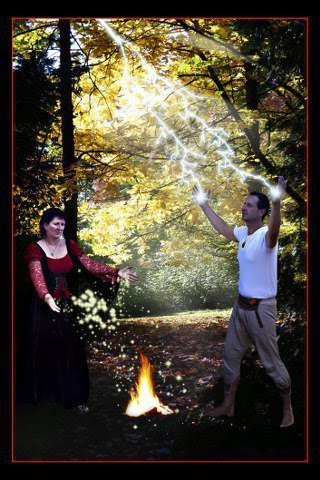Lietuvonis was the rain deity.
Medeina,Goddess of the forests.
Eþerinis, a spirit of lakes
Upinis, a spirit of rivers
Blizgulis, a god of snow. His name means "that who glitters."
Bangpûtys, the god of the seas and storms
Mokas, a stone with an ability to teach people, sometimes they are found in families - with wife Mokienë and children Mokiukas
Perkunas,The Thunderer,The Showerer"he strikes down the trees" and destroys "the wicked (clouds)," at other times in folklore, when Perkunas speaks a wonderful gleam is accompanied with his words which brings refreshment and gives birth to plants for man's enjoyment.
Eþerinis, a spirit of lakes
Upinis, a spirit of rivers
Blizgulis, a god of snow. His name means "that who glitters."
Bangpûtys, the god of the seas and storms
Mokas, a stone with an ability to teach people, sometimes they are found in families - with wife Mokienë and children Mokiukas
Perkunas,The Thunderer,The Showerer"he strikes down the trees" and destroys "the wicked (clouds)," at other times in folklore, when Perkunas speaks a wonderful gleam is accompanied with his words which brings refreshment and gives birth to plants for man's enjoyment.
These are but a few of the Gods that I feel I have drawn closer to understanding their divine Natures. No matter what you call them in your own tradition, the spirit or energy is still the same. Geoff,Tre and I just returned from an amazing trip to New Zealand, where The Goddess of Nature is still very much alive in her Mighty, Awesome magnificence.
As most of you know me,my feelings for the Gods and Goddesses run deep. I have humbling feelings of insignificance when I am in the awesome Majesty present in the holy places in Nature. Words cannot express what the Gods have given to me through visiting New Zealand.
As most of you know me,my feelings for the Gods and Goddesses run deep. I have humbling feelings of insignificance when I am in the awesome Majesty present in the holy places in Nature. Words cannot express what the Gods have given to me through visiting New Zealand.
The Mighty Power of The Goddess of the Forests of Ancient times,that even today,still contain that sacred Power that the Ancient People reverred Medeina, to the Balts, this Goddess of the Forests, represents the Earths Power which comes from the Eternity of Eternities. Medeina is great, in war and peace, her name was used for strength and protection. Medeina still lives in the hearts of her people. She continues to sustain the cycle of life and death in her hands,as her ecosystem revolves and replenishes continually and so must we if we are to survive. The Goddess of the Forest has taught me to be humble and know my small place in this World is still special enough for her to sustain and nourish.
Gods of Stone and Rock,through your mighty peaks and in your Holy places, you have taught me your wisdom. Your Wisdom of how to last through the ages as you have,slowly eroding and changing with your environment, with our World. You are not as unchanging or unyielding as I once thought. Though your core essence remains the same,your exterior,though firm in its constitution, will eventually erode,change shape and appearance, just as all life must. Just as I must remain firm in my ways to create and maintain harmony in my life but not totally unyielding to the elements that may at times need to reshape you.
The Gods of Water,in so may forms did we meet in New Zealand. Water, Snow and ice,.as Lakes,Waterfalls, Mighty Rivers,Streams and Springs that bubble up with the Living Healing Waters from deep within the Earth,and of course Oceans that go on forever, sustaining all Life. The constant cycle that Water has taken from the beginning of time that continues to maintain and Nurture all Life. From Springs that well up from deep underground caves and caverns,which flow onto the creeks, rivers,lakes and onto the Ocean and eventually to the clouds of the Sky where the Thunderer Perkunas sends back to Earth to Bless all Life again. The timeless patience and the endless toil of these Gods are recognised and honoured. Your Tireless and eternal reformation of this planet is not given enough credit in our modern world. You teach me of the profound secrets of your life which will always create,erode and refashion the world around us. Water teaches me to keep these secrets Holy and it will transform you as necessary throughout this life and onto the next,just as water transforms many times on its journey from the Earth to the Sky and back again to the Mother Earth from which it sprang.
The combination of these 3 Mighty forces at the same time manifests a vortex of Power that can make you tremble and even reduce you to tears. If you appease the Gods, they will look after you. Fair statement,but some may not know how to appease these Gods. It's simple really and they don't demand alot. Honour and Respect appeases the Gods. This means-No littering,No spitting or urinating in sacred waters,helping and defending nature, not raping Her. For example,by putting a birds Nest Fern upright so it might grow easier rather than taking it home for the Garden. Also, most important is to say a short prayer to the Spirits, Gods and Goddesses of that area,to give them honour and ask them to keep you safe.
I hope my account of my recent brush with the Divine will help anyone on their own journey to connect with the World we live in.
I hope my account of my recent brush with the Divine will help anyone on their own journey to connect with the World we live in.
Zemyna Protect
Laima Bless
Steve



